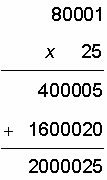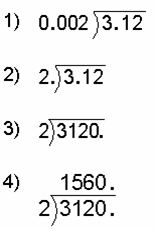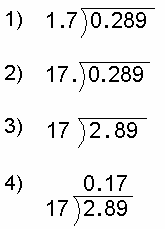Decimals
Multiply and Divide Decimals
Multiply Decimals
To multiply two decimals
- Write the decimals as whole numbers without a decimal point (Example: 5.007 becomes 5, 007)
- Multiply the numbers (Put the larger whole number over the smaller)
- To place the decimal point in your answer, start on the right and move the decimal to the left the number of spaces equal to the sum of the decimal places in the multiplied numbers.
Examples: Multiply the following decimals.
| 1) 0.0051 x 30.1 | 2) 8.0001 x 2.5 | |||
 |
Since the original fractions have a combined total of 5 decimal places, we write the final answer as: 0.15351 |
 |
Since the original fractions have a combined total of 5 decimal places, we write the final answer as: 20.00025 |
|
Practice 1: Multiply the decimals.
1) 6.53 x 0.07 |
2) 8.02 x 1.3 |
3) 21.09 x 4.43
|
Divide Decimals
To divide two decimals
For example:
3.12 ÷ 0.002
0.289 ÷ 1.7
- Set up the division problem as usual
If the divisor (in this case 0.002) is not a whole number, move the decimal point to the right to make it a whole number. (The decimal point is shown in the example, but you do not need to write it in the divisor). - Move the decimal point in the dividend (3.12) the same number of place we moved the decimal point in the divisor (We may need to add zero(s) to the end in order to move the required number of spaces).
- Divide as usual until the answer terminates, repeats, or until you can round off to the required decimal place. Insert a decimal point in the answer aligned with the decimal point in the dividend.
3.12 ÷ 0.002  |
0.289 ÷ 1.7 |
Practice 2: Divide the decimals. Round to the nearest thousandths place where appropriate.
1) 6.543 ÷ 0.09 |
2) 8.06 ÷ 1.3 |
3) 21.09 ÷ 4.43 |


